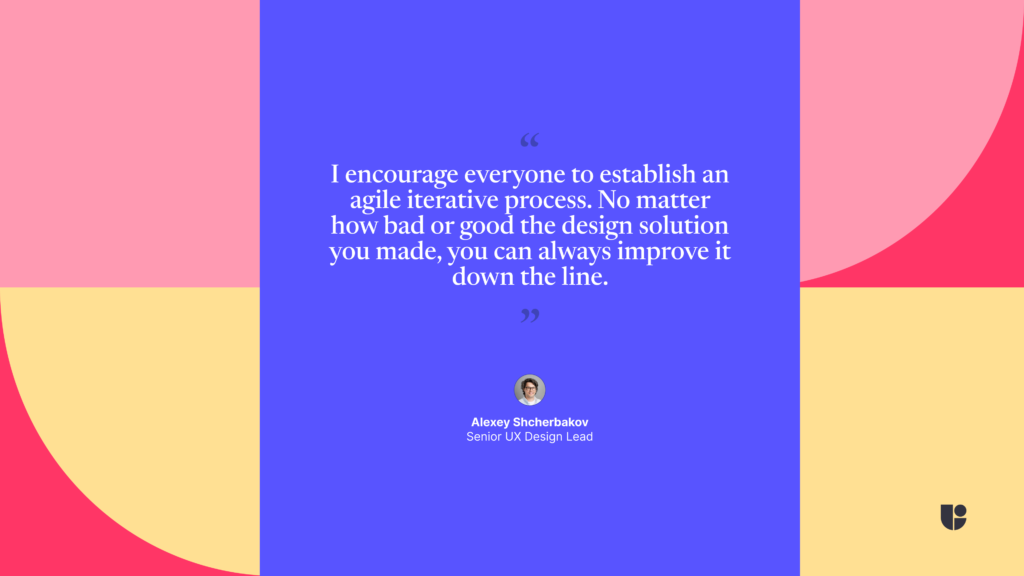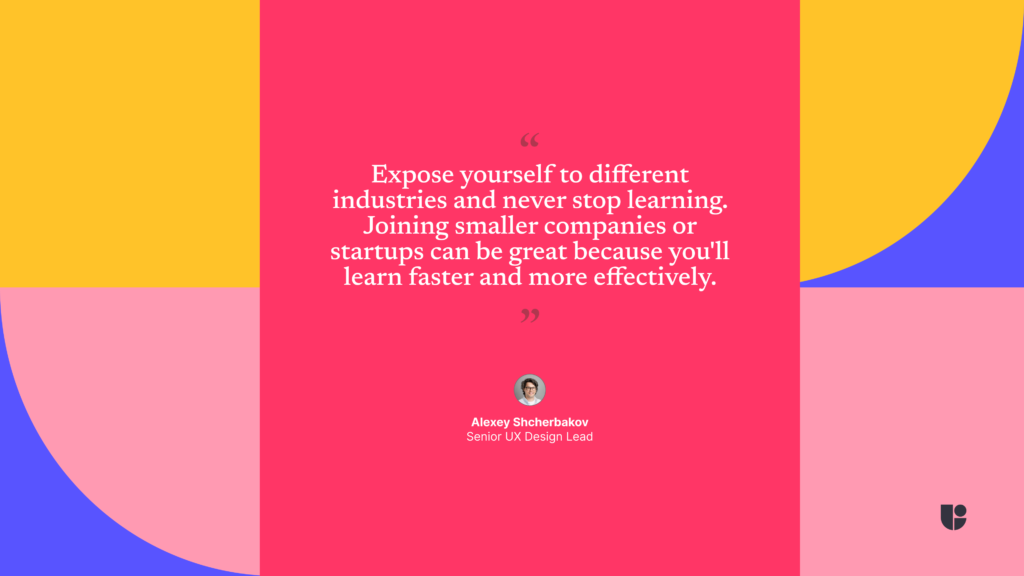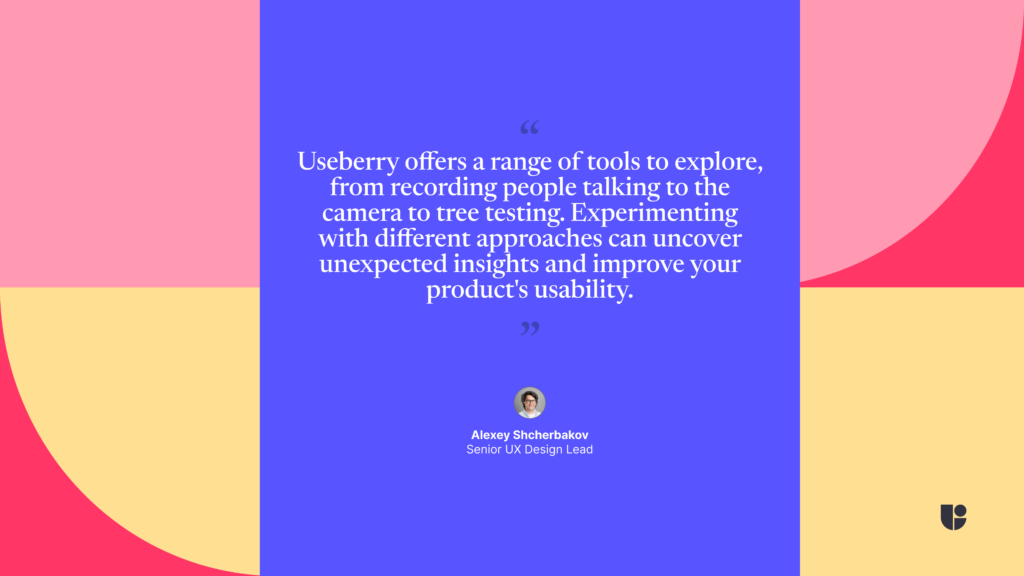In our interview with Alexey Shcherbakov, Senior UX Design Lead, we explore the value of continuous learning and adaptability in the dynamic world of UX design. Alexey believes that to stay ahead, every UX designer must constantly seek new knowledge, embrace emerging technologies, and remain curious about the evolving needs of users. By applying this mindset, we can create more impactful user experiences and maintain a competitive edge in our industry.
Let’s get started!
Design Journey: From Architecture to Designing Apps

What pivotal moments in your education or early career steered you towards a specialization in UX?
My path to UX was winding, but in retrospect, it’s easy to connect the dots. I studied architecture at one university and product design at another. Then, I pursued my master’s in industrial design with a heavy emphasis on business. Looking back, it’s clear that all three were about user experience, whether it was crafting an experience in a physical space, with a tangible product, or within a business model around it. The pivotal moment came during my master’s, coinciding with the rise of the app economy. I witnessed how young innovators with limited resources were able to create apps, services, and then build successful businesses around them. I wanted to be one of them. I followed that trend and transitioned from designing physical products to designing digital ones.
How has working across various industries shaped your unique approach to UX design?
Firstly, exposing myself to various industries was a lot of fun. I worked on something new every 6 months, thus encountering a diverse range of design challenges and digital products. Secondly, working in different types of companies helped me shape my design toolbox with methods and skills that are effective regardless of the design challenge at hand. Advertising taught me how to package ideas, digital agencies guided me in bringing stakeholders on the journey, startups provided insight into the core value proposition, and big corporations demonstrated how to execute as part of a large team. I have nothing to compare it with because it was my journey, but I highly recommend considering this approach if you’re just starting a career in UX.
What role does user testing play in your design process?
In one word – it is crucial. When it comes to designing a product, you need constant feedback from your users to understand whether you are going in the right direction. Otherwise, the chances of wasting time and money on something that people can’t use or don’t need are very high. It sounds so obvious, and everybody knows it; however, I still see so many times designers not doing it. I’ve been there, I understand why – it’s not easy to convince project stakeholders to spend a week or two on research when designs need to be ready tomorrow. The lack of time and budget are typical show-stoppers for user testing. But platforms like Useberry solve it. With it, you can get feedback within a few hours without breaking the bank. User testing is the bread and butter of any UX and product designer, and Useberry makes it very accessible.
Design Wisdom: Navigating Challenges, AI, and the Power of Learning

How do you find the right balance between incorporating user feedback and following your design intuition?
If the user feedback is clear, I rely on it. If not, I follow my expertise and best practices. However, there is never time to test everything, so I usually prioritise high-usage features with uncommon interface patterns that my intuition says could cause usability issues. It’s important to remember that user feedback is one of the aspects that, as a UX designer, you consider. The business goals and technical feasibility are equally important. Therefore, all three need to be considered in the decision-making process. But I encourage everyone to establish an agile iterative process. No matter how bad or good the design solution you made, you can always improve it down the line. Because at the end of the day, you won’t know for sure whether the solution is working as intended until it’s released and people use it in the real world. You can only minimise uncertainty in pre-production by relying on best practices, common patterns, and user research.
Are there any emerging UX trends that excite or concern you?

The elephant in the room is AI. It will change all industries, including design. What excites me most is how AI is speeding up design iterations and democratising the field. More designers can now build products as solo entrepreneurs through tools like “vibe coding”, which breaks down traditional barriers to creating innovative products. It’s still developing but progressing quickly. Not long ago, I made this video about AI tools for designers, and the AI capabilities have already advanced a lot since then. What concerns me is the rise of “AI slop”. We’ll likely see a lot of attractive designs that aren’t actually usable. AI makes it easy to generate pretty interfaces or copy existing ones. This may result in a spike of unusable interfaces. I’m also concerned about how far automation might go and whether it’ll shift designers from hands-on creators to more like project owners.
What golden piece of advice would you give to those just embarking on their UX journey?

I’ll share two pieces of advice: expose yourself to different industries and never stop learning. The UX design role always varies from one company to another. In the beginning of your career, try working in different places to see which variation of UX suits you best. Joining smaller companies or startups can be great because you’ll learn faster and more effectively there. Agencies are also fantastic because they offer opportunities to work across various industries, helping you discover what resonates with you the most. Plus, it boosts your chances of landing future jobs since recruiters and HR often seek candidates with versatile experience, and agencies usually expose you to a vast range of opportunities. Second piece of advice: never stop learning. Throughout your career, you’ll need to acquire many skills beyond just the basics of design. Our industry is driven by technology, which is constantly evolving. So, to stay relevant and maintain a competitive edge, keep learning! This is especially relevant in the age of AI.
AI’s influence is growing in UX design. Has AI impacted your workflow or decisions? What challenges do you foresee in integrating AI into UX design?
Yes, AI has definitely impacted my workflow. I use it to handle time-consuming tasks like summarising meeting notes, checking emails, processing customer feedback, brainstorming interface solutions, and identifying gaps in my thinking. This frees me up to focus on the work that I want to do and helps me deliver faster. The main challenges I see are around employment and expectations. There’ll likely be fewer junior and mid-level design roles as AI handles routine work. The bar will be higher for all designers – we’ll need to work faster, deliver better quality, and take on broader responsibilities. Most importantly, as design tools become accessible to non-designers, we need to prove our value through strategic thinking, business understanding, and complex problem-solving rather than just making things look good.
Getting the Most from Useberry: Making Data-Driven Design Decisions

Can you tell us about the impact of UX research on your design process and the tools/methods you use?
Research forms the backbone of my design approach. At the end of the day, we’re creating products and experiences for real people, so learning about their needs, behaviours, and pain points is critical. Research doesn’t just inform my design decisions; it also helps justify decisions to stakeholders, ensure alignment across teams, and minimise wasted development efforts.
UX research encompasses a wide range of methods, and a couple stand out as my go-to. Usability testing, both qualitative and quantitative, using metrics like the Single Ease Question (SEQ), has been my primary method lately. It’s often important to discover usability issues with a qualitative approach first and then validate them at scale in quantitative studies. Then there’s heuristic analysis and digging into analytics tools like Adobe Analytics, alongside reviewing notes from Customer Call Centre representatives. And lastly, even though they don’t get as much use, card sorting and tree testing are research approaches that I sporadically use but still find important. Ultimately, research is an integral part of being a user advocate. The more we can rely on direct user inputs throughout the process, the better positioned we’ll be to create experiences that provide value and help the business thrive.
Could you describe a situation where Useberry’s tools made a significant difference in your project?
A couple of examples come to mind, but I’ll share this one. During a critical project, the design team had differing opinions on the accessibility of two design versions for a key screen. As the designs were in pre-production and urgently needed for development, we decided to conduct a quantitative usability test using Useberry. By targeting users with diverse abilities, we obtained valuable feedback on both designs. This feedback provided clear-cut data that ultimately guided our decision and enabled us to meet our delivery deadline.
For those new to Useberry, what advice or tips would you offer to maximize the benefits of the platform?
Use it often. It’s fast and affordable, making it easy to incorporate regular testing into your routine. Remember – testing even with just a handful of participants is better than no testing at all.
Don’t hesitate to get creative with it. Useberry offers a range of tools to explore, from recording people talking to the camera to tree testing. Experimenting with different approaches can uncover unexpected insights and improve your product’s usability.
UX Industry and Environment in Australia
How would you describe the current state of the UX industry in Australia, especially in comparison to global trends?
I’ll answer based on what I’ve personally noticed. The UX industry here has been steadily growing, aligning with global trends towards prioritising user-centred design. Aussie businesses across various sectors have really caught on to the importance of UX, which has led to a higher demand for UX professionals. It really took off during the pandemic, but now it seems like things have levelled off a bit.
From what I’ve seen, the most common employers of UX professionals in Australia are government, banks, retail, and consulting agencies. I’d say these industries have a bigger impact on the local state of UX than big tech does. So, while everyone’s excited about designing for new tech trends, most projects tend to stick to more established platforms. And of course, everyone is closely watching how AI will impact the field.
In what ways do you think Australian culture influences UX design and research practices?
Australian culture influences UX design and research practices in several ways, particularly through its inclusivity and environmental awareness. With our diverse population, UX designers prioritise inclusive design approaches to ensure digital experiences resonate with users from various cultural backgrounds. This focus on inclusivity extends to making accessibility a top priority. A lot of it comes from the government, but it is definitely heavily supported by the community, reflecting our commitment to create equitable experiences for all.
Moreover, growing environmental awareness shapes business priorities and grows adoption of planet-centric design principles. UX designers are increasingly mindful of the environmental impact of their designs, opting for minimalist interfaces and energy-efficient features, as well as a growing number of opportunities to work on products or features with a positive environmental impact.
While both inclusivity and environmental awareness trends are common globally, I believe they resonate strongly with local communities, businesses, and UX designers.
What unique challenges and opportunities do UX professionals face in Australia?
In Australia, UX professionals face some unique challenges and exciting opportunities. The market isn’t as massive as some global hubs, which means there might be fewer job openings and project variety. On the flip side, it also means we’ve got a close-knit community where collaboration and networking are easier.
Another thing we have been witnessing is folks from different backgrounds like marketing and graphic design jumping into UX, especially since the pandemic. It brings fresh ideas and skills to the table, which is awesome. But it also means there’s more competition for jobs, so staying up-to-date and adaptable is key. Overall, it’s an ever-changing landscape here, but with plenty of chances to grow and make an impact.
What advice would you give to UX professionals in Europe or elsewhere looking to enter the Australian UX market?
Nine years ago, I landed a job remotely and moved here, but it’s tougher now. You’ll likely need at least three years of experience to break into the Australian UX scene, especially with so many local experts and stricter migration rules. But it’s not impossible!
During interviews, don’t just focus on hard skills. Aussie employers love soft skills like communication and problem-solving. Show you can work well with others and explain things clearly – that’ll make you stand out.
Also, if you’re eyeing a job with a big global company like Amazon, Google, or less known ones, try joining their team in your own country first. Once you prove yourself, they might help you move over to Australia. This approach not only simplifies the visa process but also provides a familiar work environment and support network, easing the transition to the Australian UX market.
Fun Round
Could you share an unexpected source of inspiration that has impacted your approach to UX?
Observing people of different ages using technology in public has been an eye-opening experience. Whether it’s older adults navigating smartphone apps or younger generations interpreting a door sign, these observations highlight the importance of the saying ‘you are not your users’, emphasising the need for designing inclusive interfaces for users of all ages and digital literacy levels. It has made me more conscious of clear communication and designing for diverse users, shaping my approach to UX.
If you could travel back in time and redesign any product, which would it be, and what would you change?
Nothing aspirational and grandiose comes to mind. I would pick something mundane and used by a lot of people while still lacking usability – the TV remote. Even today, most TV remotes are overwhelming with a multitude of buttons and options, making it confusing and frustrating for users to navigate. My grandma, who is in her 80s, always struggles to use one and often accidentally presses the wrong buttons.
My approach would focus on streamlining the remote’s layout, prioritising essential functions while decluttering unnecessary buttons. I would simplify the design without going overboard like the Apple TV remote, where simplicity sometimes compromises usability. However, by reducing complexity and making the remote more intuitive to use, I believe it would enhance the overall user experience and make watching TV more enjoyable and effortless. After all, simplicity shouldn’t come at the cost of usability but rather complement it to create a more user-friendly product.
Are there any “must” routines for you while working on a project?
The must routines would be those that help to look after myself and people on the project. I make sure to get enough sleep, eat a healthy meal at least once a day, and learn new things outside of the project to stay inspired. But most importantly, I follow a ‘people-first’ mindset and have regular catch-ups to ensure everyone feels heard, motivated, and valued.
Disclaimer: The views shared in this interview are Alexey’s own and do not represent those of his employer.
Connect with us!
Curious about how Useberry can enhance your UX and Design journey? Contact us to ask a question or to arrange a personalized demo.




